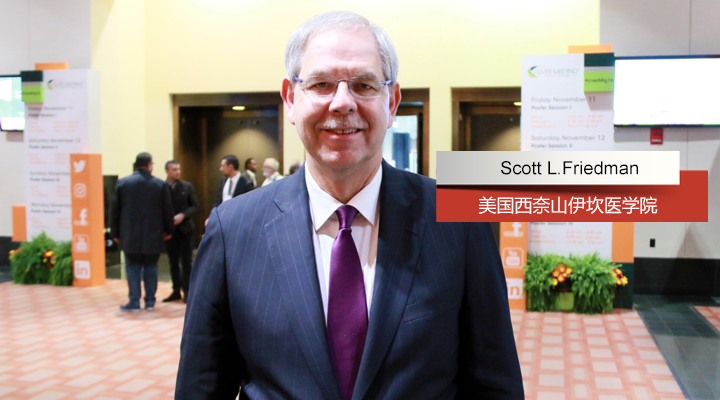当前位置:AASLD-美国肝病研究学会年会 » 正文
[AASLD大家访谈]“杰出成就奖”获得者Scott L. Friedman教授介绍:肝纤维化机制、无创诊断、新药研发及抗纤维化治疗
—— 作者:Scott L. Friedman 时间:2016-11-16 05:52:07 阅读数:
3439

编者按:“第67届美国肝病研究学会(AASLD)年会”上,揭晓了2016年度AASLD三大杰出奖获得者,分别是Scott L. Friedman(杰出成就奖)、T. Jake Liang(杰出临床教育/导师奖)和Gregory J. Gores(杰出服务奖)。在昨天(15日)的微信中,我们推送了Gregory J. Gores教授关于肝癌领域亮点的采访,今天继续为您带来“杰出成就奖”获得者、美国西奈山伊坎医学院Scott L. Friedman教授的专访。
Friedman教授为本刊特邀顾问,曾担任2009年AASLD主席,他在肝纤维化的发生机制、诊断和治疗领域有卓越成就。采访中,他从肝纤维化发病机制、无创性指标、抗纤维化研发,及有效抗病毒治疗患者是否需要接受抗纤维化治疗方面一一进行解答。
《国际肝病》:近年来,在肝纤维化发病机制的认识方面,取得了哪些重要进展?
Scott L. Friedman教授:在过去的二十年里,关于肝纤维化的发病机制有许多新发现。最重要的发现是识别活化的肝星状细胞,肝星状细胞是肝胶原蛋白及纤维素化的主要来源。最近,我们已经开始了解其他细胞怎样与星状细胞联系进行纤维化修饰,特别是巨噬细胞和自然杀伤细胞的作用,它们可以调节纤维化进展和转归,并影响细胞外基质的降解。我们希望进一步探索发现肝纤维化逆转的新特征,这样,我们就可以利用这些特征来开发新的治疗方法。
Prof. Friedman: The pathogenesis of fibrosis has yielded many new discoveries over the past twenty years. The most important has been the identification of activated stellate cells as the major source of hepatic collagen and fibrosis. More recently, we have begun to understand how other cell types interact with stellate cells to modify fibrosis, in particular the role of the macrophages and natural killer cells that can modulate fibrosis progression and regression, and alter the degradation of extracellular matrix. Increasingly, we are looking to unearth and understand new features of fibrosis regression because we would like to exploit those features as we develop new therapies.
《国际肝病》:目前,临床最常用哪些无创性指标对肝纤维化程度进行评估?
Scott L. Friedman教授:如何获得更好的无创性指标已经得到临床医生的广泛关注。目前,最有前景的指标似乎是通过瞬时弹性成像或磁共振弹性成像测量肝脏硬度。当然,肝脏的硬度本身并不能代表肝脏纤维化的程度,但对于大多数慢性肝病患者而言,磁共振弹性成像测得的肝脏硬度值对于反应肝脏纤维化程度,似乎是一个有用的指标。还有新的血清标记物指标,可以检测最近被降解的胶原蛋白的特异片段,这种方法更敏感。这其中的一些标记正在进行临床试验。此外,还有一些功能检测指标,包括美沙西丁呼气试验和胆酸钠分流试验,反应肝脏的储备功能,而不是反应肝脏的组织学特征。所有这些指标目前都处于临床试验阶段,没有任何一个被批准用于临床使用规范。
Prof. Friedman: There is tremendous interest in better non-invasive markers. Currently, the marker that looks most promising is the use of transient elastography or MR elastography, which measures liver stiffness. Of course, stiffness by itself does not mean more fibrosis, but in most patients with chronic liver disease, liver stiffness measured by MRE appears to be a helpful surrogate marker to correlate with the degree of fibrosis. There are also new serum markers that are more sensitive that can detect specialized fragments of collagen that have recently been degraded. Some of those are being tested in clinical trials. In addition, there are function tests, including the methacetin breath test and cholate shunt test, which measure the functional reserve of the liver rather than the histology. All of these are being tested in clinical trials. None of them have been approved for standard clinical usage.
《国际肝病》:研发抗肝纤维化治疗的最大障碍是什么?
Scott L. Friedman教授:毫无疑问,快速研发抗纤维化药物的最大障碍是缺乏可以替代活检的非侵袭性检测指标。正如我之前提到的,虽然我们取得了一些进展,但是,目前临床试验任何一种新药都必须依赖于肝脏活检。在今后的试验中,我们希望通过血液检测、影像学检查或功能检查指标,替代目前使用的肝脏活检,获得相同的药效学证据。
Prof. Friedman: Without question, the single biggest obstacle to accelerating the pace of antifibrotic drug development is the lack of non-invasive markers that can replace biopsy. As I mentioned, we are making progress, but in 2016, any clinical trial testing a new drug must rely on liver biopsy. We are desperate to avoid liver biopsy in future trials by finding blood tests or imaging tests or functional tests that will yield the same evidence of drug efficacy as what we currently use liver biopsy for.
《国际肝病》:有什么潜在的抗纤维化药物正处于临床试验研究吗?
Scott L. Friedman教授:是的。令人激动的是,有许多药物正处于动物实验阶段,也有一些药物已经提前进入临床试验阶段。特别是,Intercept公司生产的奥贝胆酸目前正处于第Ⅲ期临床试验阶段。目前,Genfit 公司生产的PPAR-γ激动剂elafibranor在美国和欧洲处于第Ⅲ期临床试验阶段。在Ⅱ期临床试验研究中,我们发现CCR2/CCR5拮抗剂和ASK1拮抗剂是大有前途的。所以,在未来2~3年内,将会有许多药物进入Ⅱ期临床试验阶段。
Prof. Friedman: Yes. It is an exciting time because there are many drugs that are being tested in animals and some that are already in advanced testing in humans. In particular, the drug from Intercept, obeticholic acid, is currently being tested in a phase III trial. Similarly, the PPAR-delta agonist elafibranor from Genfit is currently undergoing phase III testing in the United States and Europe. In phase II studies, antagonists to CCR2/CCR5 and antagonists to ASK1 have been found to be promising. So there are many drugs in the clinical development pipeline that should reach phase II within the next 2-3 years.
《国际肝病》:目前可用的抗病毒药物对慢性乙型肝炎和丙型肝炎患者非常有效,患有显著肝纤维化的这些患者还需要抗纤维化治疗吗?
Scott L. Friedman教授:这是一个非常好的问题,病毒性肝炎尤其在中国和整个亚洲地区比较常见。很明显,尽管有些患者对抗病毒治疗产生了完全反应,但是他们的纤维化程度太严重,以至于我们不得不考虑抗纤维化治疗,或者继续抗病毒治疗。当治疗病毒性肝炎患者时,我们不知道哪个晚期纤维化患者会发生纤维化逆转,但我们必须继续追踪所有使用抗病毒药物获得有效治疗的患者,因为他们可能存在发生肝细胞癌的持久风险。我们需要研究已经经过治疗的乙型肝炎和丙型肝炎患者发生持久肝纤维化或肝硬化的可能性。我希望我们可以找到发生持久肝纤维化的原因,对那些对抗病毒治疗反应良好但仍需要抗纤维治疗的患者进行抗纤维化治疗。
Prof. Friedman: That’s an excellent question, particularly because viral hepatitis is so common in China and throughout Asia. It is very clear that despite some patients having a complete response to antiviral therapy, they have fibrosis that is so advanced that we may have to consider antifibrotic therapy in addition to or following successful antiviral therapy. We don’t know which patients with advanced fibrosis will have fibrosis regression when we treat their viral hepatitis, but we must continue to follow all patients who are treated effectively with antivirals because of the persistent risk of hepatocellular carcinoma. We have a lot to learn about the likelihood of persistent fibrosis or cirrhosis in patients who are already being treated for hepatitis C or B. I expect that eventually we will identify factors associated with persistent fibrosis and begin to apply antifibrotic therapies to patients who have already had a good response to antiviral therapy but still need antifibrotic treatment.
标签:
访谈
专家访谈
肝纤维化
发表评论
全部评论